Phone: (585) 902 2822
Email: info@jimmysuits.com
Tailored Elegance, Timeless Confidence.
Tailored Elegance, Timeless Confidence.
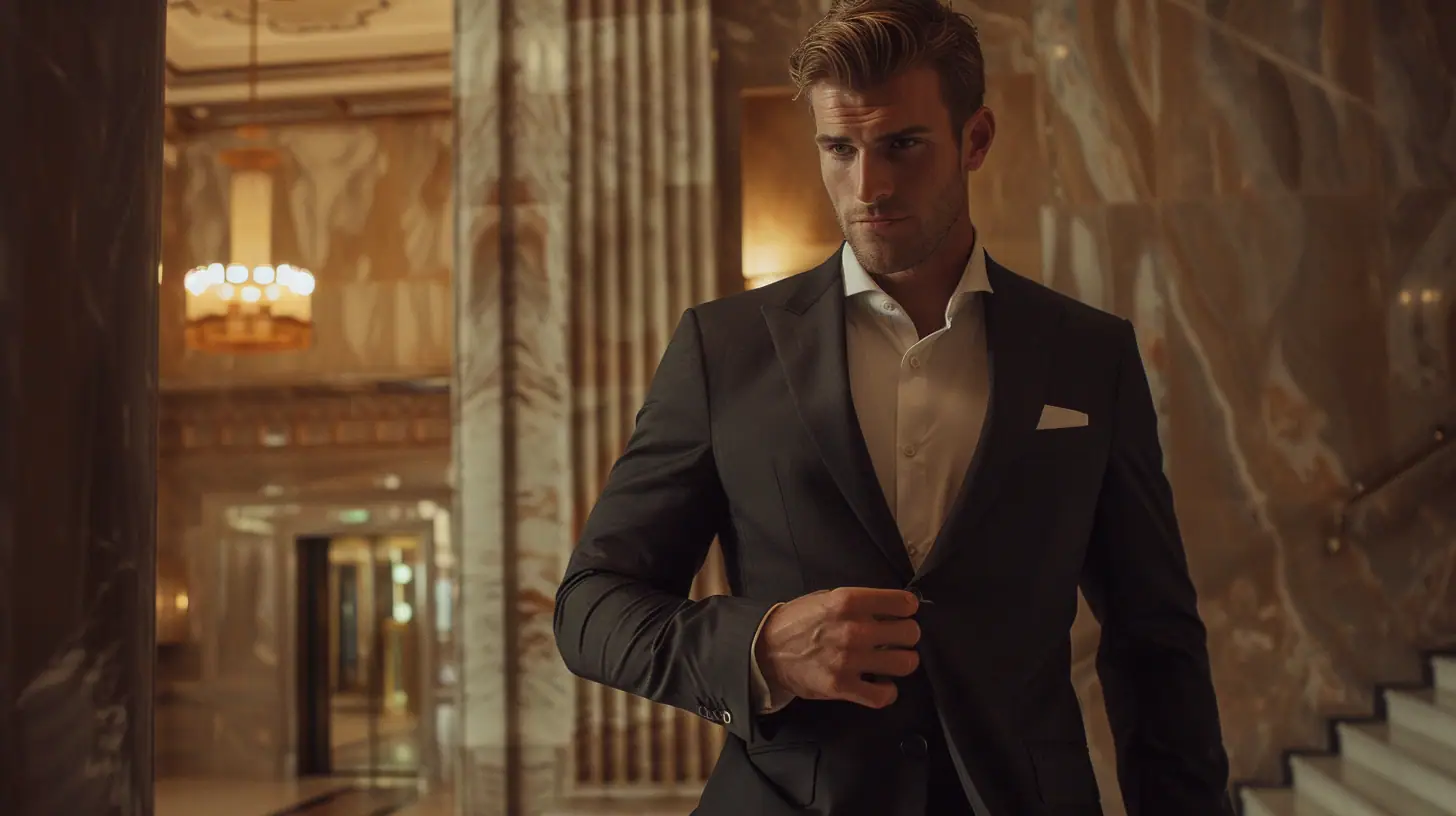
You’ll find that men button their suit jackets to maintain a polished, professional appearance and honor a tradition that began with King Edward VII in the early 1900s. When he couldn’t fasten his bottom button due to his expanding waistline, he started a trend that the British aristocracy quickly adopted. Today’s suit jackets are specifically designed with this buttoning convention in mind, ensuring proper draping and ease of movement. Proper buttoning also helps prevent fabric strain and keeps the jacket’s silhouette looking sharp. There’s much more to this sartorial custom than meets the eye.
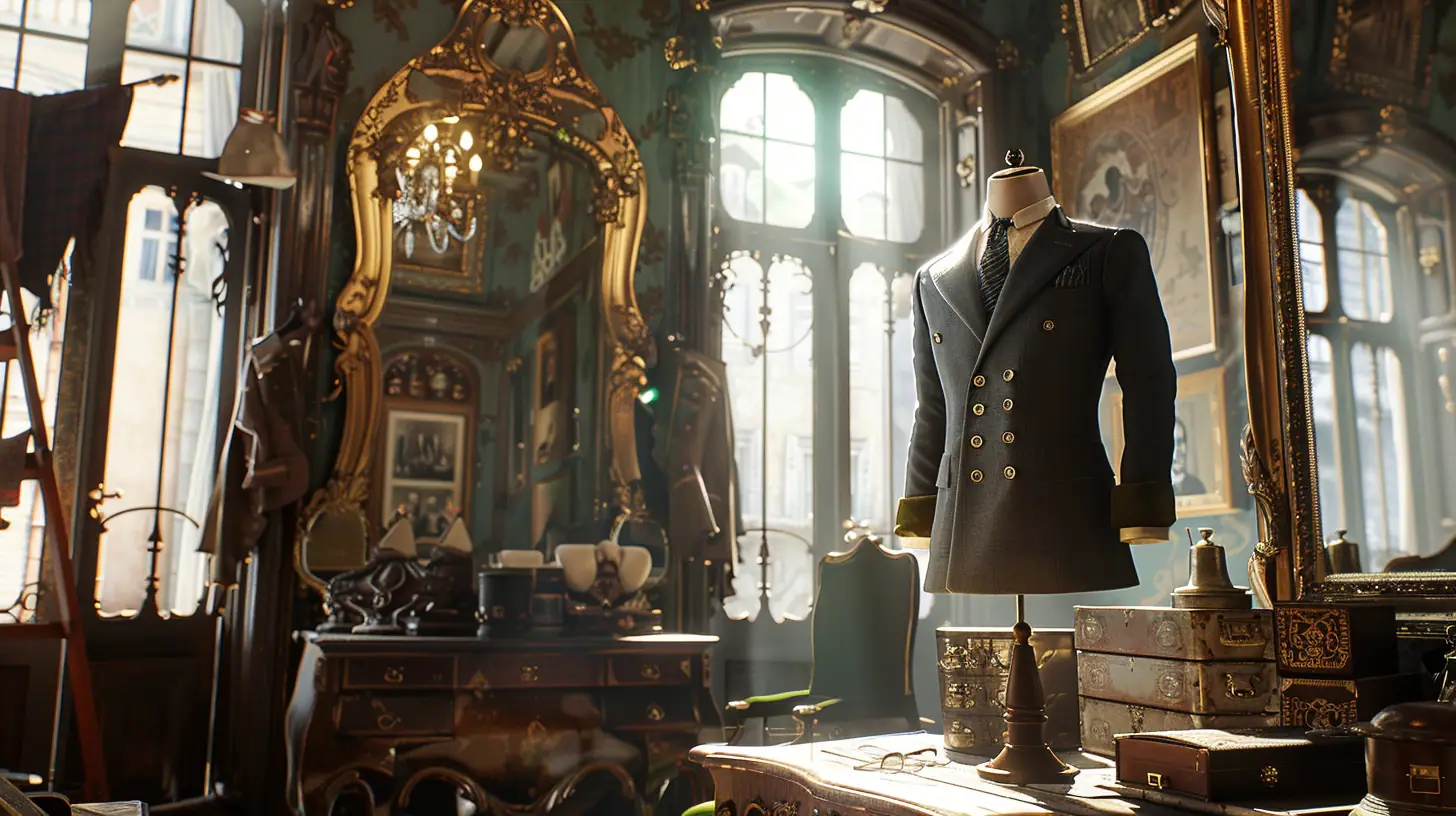
Men’s suit jacket buttoning tradition dates back to King Edward VII of England in the early 1900s. As the story goes, the king’s expanding waistline made it uncomfortable for him to button his jacket’s bottom button, so he began leaving it undone. His subjects and courtiers, not wanting to offend the king, followed suit, creating a fashion trend that’s persisted for over a century.
Before this royal influence, Victorian fashion dictated that men button all buttons on their formal attire as a sign of propriety and refined manners. The era’s emphasis on a tailored fit meant that suits were designed to be fully buttoned, creating a sleek silhouette that showcased a gentleman’s posture and physique.
You’ll find that modern suit design has evolved around this unbuttoned tradition. Today’s jackets are actually cut and tailored with the assumption that you won’t fasten the bottom button. If you were to button it, you’d notice the jacket doesn’t drape properly and creates unsightly pulling across your midsection. This design principle applies to both single-breasted and double-breasted suits.
The tradition has become so ingrained that it’s now considered a fundamental rule of men’s style. You’ll often hear the saying “sometimes, always, never” referring to the three-button jacket rule: sometimes button the top button, always button the middle, and never button the bottom.
This simple guideline helps maintain the suit’s intended shape while honoring a century-old custom that began with a king’s comfort preference.
The sartorial influence of King Edward VII extended far beyond his reign, fundamentally changing how men wear suit jackets today. As Britain’s monarch in the early 1900s, Edward’s impact on royal fashion wasn’t just about personal style – it actually stemmed from a practical necessity. You might be surprised to learn that his expanding waistline led to one of the most enduring suit-wearing customs.
When Edward found his jacket buttons becoming increasingly uncomfortable, he began leaving the bottom button of his waistcoat and jacket undone. Given his status as a fashion influencer of his era, the British aristocracy quickly adopted this practice to show their solidarity with their king. What started as a simple accommodation for comfort soon spread throughout British society and eventually became a standard practice worldwide.
Edward’s legacy in men’s fashion continues to shape how you wear a suit today. You’ll notice this influence whenever you put on a suit jacket – the modern convention dictates that on a three-button jacket, you’ll button the middle button, optionally the top one, but never the bottom. On a two-button jacket, you’ll fasten only the top button.
This practice isn’t just about following tradition; it actually allows the jacket to drape more naturally and move more freely when you’re walking or sitting. While many men today mightn’t know the origins of this custom, they’re participating in a century-old tradition that began with one king’s practical solution to a very personal problem.
While King Edward VII‘s influence on suit buttoning is well-documented, military uniforms played an equally significant role in shaping modern suit jacket conventions. You’ll find that many elements of today’s business attire can be traced directly back to military origins, where buttons served both practical and ceremonial purposes.
When you look at traditional military attire, you’ll notice that buttons were essential for protecting soldiers from the elements. They needed to be securely fastened, creating a barrier against wind, rain, and cold. The practice of buttoning up became associated with readiness and discipline, qualities that later shifted to civilian professional dress.
Button symbolism in military uniforms went beyond mere function. You’ll discover that the placement and number of buttons often indicated rank, regiment, or branch of service. This hierarchical significance helped establish the idea that proper buttoning conveyed authority and respectability.
When military officers moved to civilian life, they brought these buttoning habits with them, influencing broader fashion trends. The military’s influence is particularly evident in the standardization of buttoning practices. You’ll see this reflected in modern suit conventions, where specific rules about which buttons to fasten have become widely accepted.
The military’s emphasis on uniformity and precision in dress code has shaped how we approach formal wear today, making proper button etiquette an essential aspect of professional presentation. This military heritage continues to influence contemporary suit-wearing customs, though many men may not realize the connection to its martial origins.
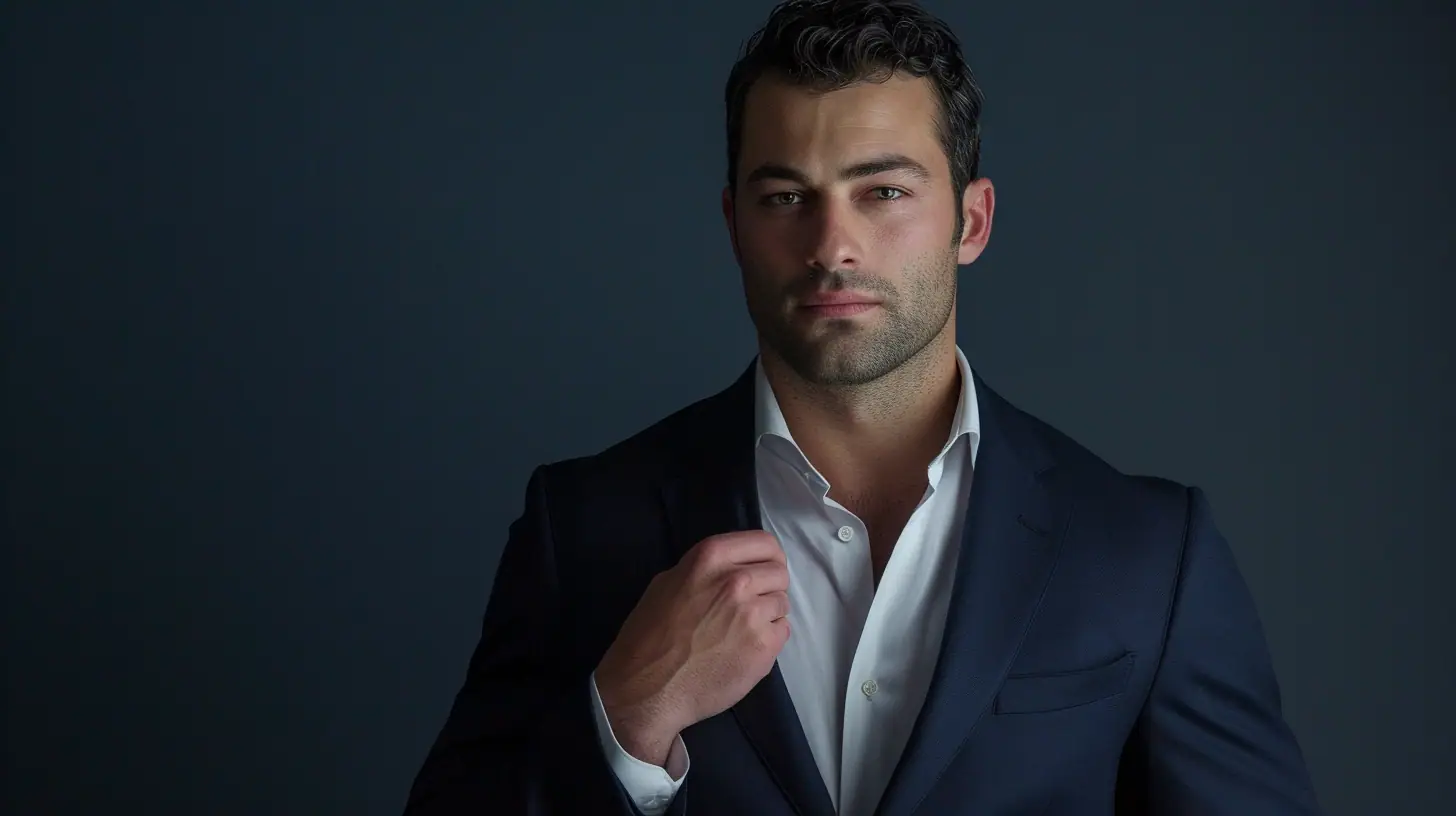
Modern suit buttoning boils down to a few essential rules that every well-dressed man should master. The most fundamental rule applies to single-breasted suits with two or three buttons. For two-button suits, you’ll always button the top button and leave the bottom one unfastened.
With three-button suits, you’ll follow the “sometimes, always, never” rule – the top button is optional, the middle button stays fastened, and the bottom button remains open.
Different button types and button styles require specific approaches. On double-breasted suits, you’ll want to keep all buttons fastened except the bottom one when standing. This helps maintain the suit’s clean lines and proper draping.
When you sit down in any suit style, you should completely unbutton your jacket to prevent pulling and preserve the garment’s shape.
The placement of buttons affects how you’ll wear them. Traditional American suits typically feature a higher button stance, while European suits often have a lower placement.
You’ll find that modern suits commonly incorporate two-button styles, as they’re versatile and flattering for most body types. When choosing between button styles, consider your height and build – higher button stances can elongate shorter torsos, while lower stances work well for taller frames.
Remember to unfasten your buttons before sitting and refasten them when standing up. This simple habit will help maintain your suit’s appearance and prevent unnecessary stress on the fabric and buttons.
Because single-breasted suits remain the most common style for business and formal wear, mastering their proper etiquette is vital.
When you wear a single-breasted jacket, you’ll find various button styles that affect how you should wear your suit. The most important factor is understanding when to button and unbutton your jacket based on the situation.
The proper etiquette depends heavily on your jacket’s button configuration and overall jacket fit. Most single-breasted jackets come in two or three-button styles, and each has specific rules. For a perfect presentation, remember these fundamental guidelines:
Your jacket’s fit plays a significant role in proper buttoning. If you’ve chosen a well-fitted jacket, it should lay smoothly against your body when buttoned, without pulling or creating visible stress points around the closure.
Unlike their single-breasted counterparts, double-breasted suits come with their own distinct set of buttoning rules. When you wear a double-breasted suit, you’ll need to keep all the functional buttons fastened while standing, walking, or sitting. This rule exists because these suits are designed to maintain their fitted, overlapping front panels at all times.
Double-breasted styles typically feature either four or six buttons, arranged in parallel rows. The most common configuration is the 6×2 arrangement, meaning six buttons with only two that function. You’ll find the working buttons positioned at your natural waistline, while the others serve as decorative elements that maintain the jacket’s symmetry.
It’s crucial to fasten both working buttons to preserve the suit’s structured silhouette and prevent the lapels from sagging. Unlike single-breasted jackets, you shouldn’t unbutton your double-breasted suit when sitting. The overlapping design means that unbuttoning would cause the front panels to separate awkwardly, compromising both comfort and appearance.
The only time you should unbutton a double-breasted jacket is when you’re removing it. Button variations can include 4×1, 4×2, 6×1, and 6×2 configurations, but regardless of the style, the rule remains consistent: keep it buttoned.
When you’re shopping for a double-breasted suit, verify the buttons align properly at your waist and the overlap sits flat against your chest without pulling or gaping. This attention to fit will help you maintain the sophisticated look these suits are known for.
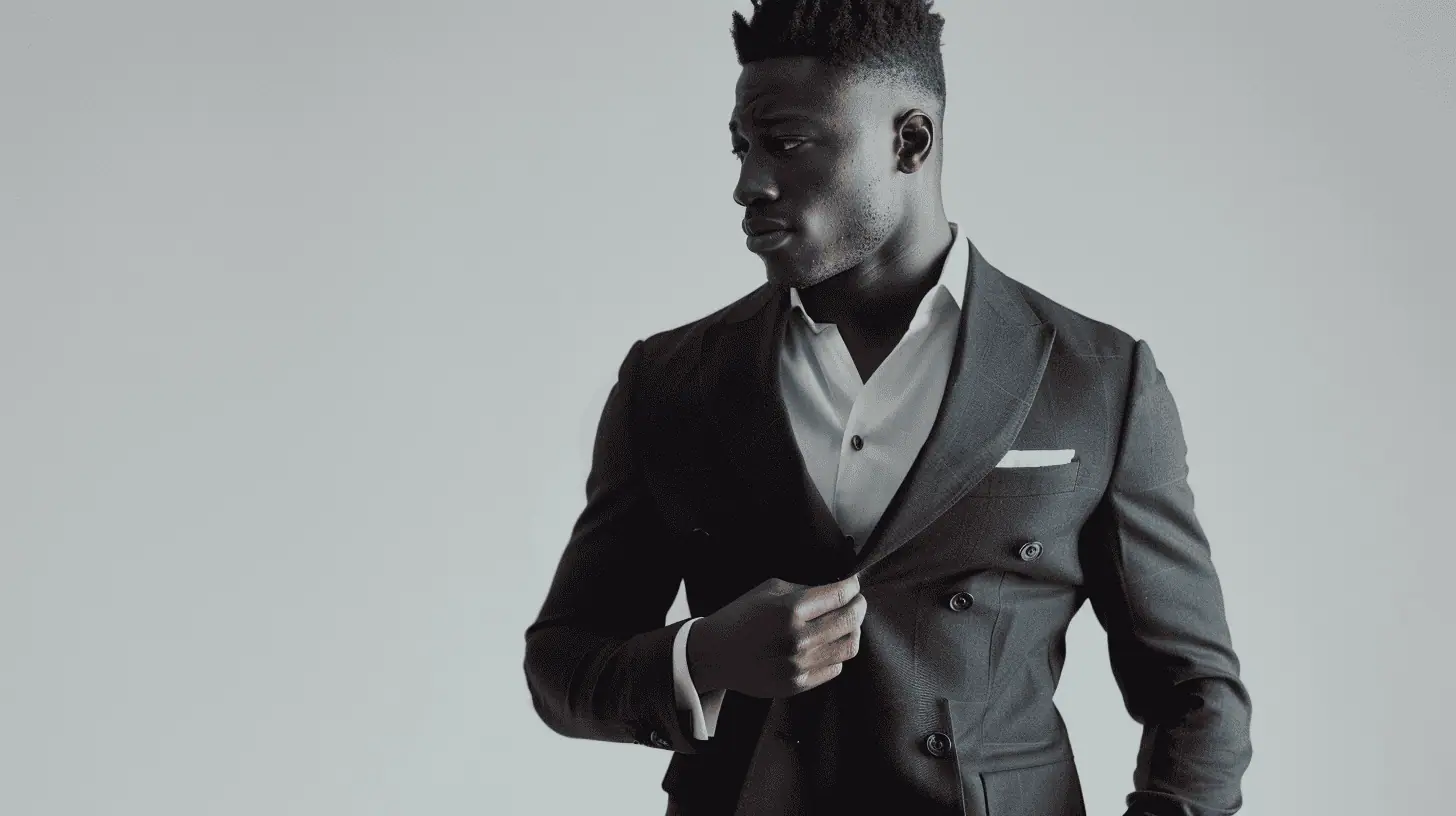
Over the past decade, suit-buttoning conventions have become more flexible as fashion trends increasingly blur the lines between formal and casual wear.
You’ll notice that modern suit trends embrace a more relaxed approach, allowing for personal expression while maintaining professional standards. This fashion adaptability reflects broader cultural shifts toward individualized style choices.
Today’s professionals are experimenting with traditional rules, adapting them to contemporary settings. You’ll find that many style influencers are rewriting the old guidelines, creating new interpretations of classic suit-wearing etiquette.
This evolution hasn’t eliminated the importance of proper buttoning; rather, it’s created space for contextual variations.
The modern approach to suit buttoning considers several factors that weren’t as prominent in previous decades:
While you can now find more flexibility in suit-wearing conventions, understanding the traditional rules remains valuable.
This knowledge allows you to make informed decisions about when to follow classical guidelines and when to embrace modern interpretations.
The key is recognizing that fashion adaptability doesn’t mean abandoning all structure – it’s about knowing the rules well enough to break them purposefully and stylishly.
Suit-buttoning traditions vary dramatically across different cultures, reflecting each society’s unique approach to formal attire. You’ll find that in Western countries, the practice often follows the “sometimes, always, never” rule for three-button jackets, while Japanese businessmen typically maintain a fully-buttoned appearance throughout the day as a sign of respect and professionalism.
In Mediterranean regions, you’ll notice a more relaxed approach, where men often leave their jackets completely unbuttoned during casual social gatherings, yet strictly follow buttoning protocols during formal events. The cultural symbolism attached to suit buttons extends beyond mere functionality – it’s a visual language that communicates social status, cultural awareness, and respect for local customs.
The global variations in buttoning practices are particularly evident in emerging markets. In China, you’ll observe a blend of Western and Eastern influences, where traditional Mandarin collar suits without buttons coexist with Western-style buttoned jackets.
Middle Eastern countries often emphasize fully-buttoned jackets in professional settings, regardless of the weather, as it represents dignity and formality.
When you’re traveling internationally, you’ll want to pay attention to these subtle differences. In South American business centers, you might notice that buttoning rules are less rigid than in European capitals, yet they maintain their own distinct preferences.
Understanding these cultural nuances isn’t just about fashion – it’s about showing respect for local traditions and demonstrating your cultural intelligence in global professional settings.
Three key factors determine proper button placement on a suit jacket: proportion, balance, and functionality. When you’re looking at button placement, you’ll notice that proper alignment creates visual symmetry that enhances your overall appearance. The buttons should follow your body’s natural lines while maintaining practical usability.
Button alignment plays an essential role in how your suit hangs on your frame. You’ll find that well-placed buttons help create a flattering silhouette by hitting at the right points on your torso. The top button of a two-button suit should sit just above your navel, while the bottom button should fall naturally below it.
Here’s what you need to know about proper button placement:
When you’re having a suit tailored, make sure your tailor considers your body type when placing buttons. A taller person might need slightly different spacing than someone shorter to maintain proper proportions.
You’ll want to check that the buttons don’t pull or create unsightly wrinkles when fastened, as this indicates improper placement. Remember that proper button placement isn’t just about aesthetics—it’s vital for the suit’s functionality and your comfort.
Throughout history, the way a man buttons his suit jacket has served as a subtle indicator of social standing and refinement. When you properly button your suit jacket, you’re participating in a centuries-old tradition that communicates status perception and attention to detail. This simple act distinguishes those who understand formal dress codes from those who don’t.
In professional and social settings, your buttoned suit jacket creates a polished silhouette that impacts how others perceive your authority and competence. The power dynamics at play are subtle but significant – a properly buttoned jacket suggests you’re familiar with established customs and etiquette. You’ll notice that influential figures, from business executives to political leaders, consistently maintain this standard.
When you leave your jacket completely unbuttoned, you risk appearing casual or uninformed about traditional suit-wearing conventions. This can affect how seriously others take you, especially in formal situations where dress codes carry significant weight. Even in modern times, you’ll find that understanding and following these buttoning rules helps establish your credibility in professional circles.
Your attention to proper jacket buttoning demonstrates respect for the occasion and those around you. It shows you’ve invested time in learning the nuances of formal dress, which often correlates with social sophistication.
Whether you’re attending a business meeting, wedding, or formal event, your buttoned suit jacket serves as a visual shorthand for your understanding of social customs and your place within them.
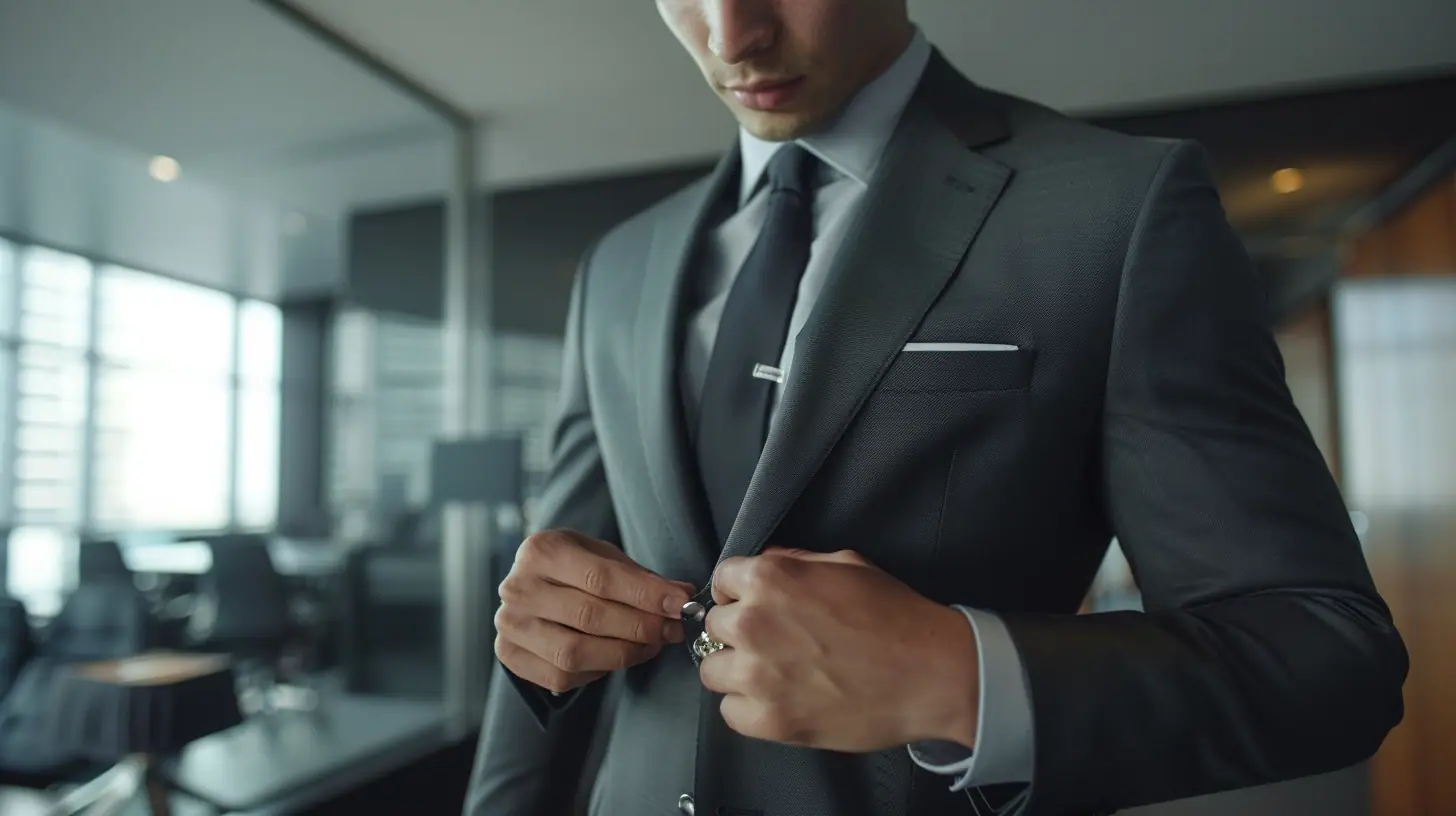
Professional guidelines for suit buttoning follow a clear set of rules that you’ll find consistent across modern menswear.
Whether you’re attending a business casual meeting or a formal event, proper buttoning etiquette communicates your attention to detail and understanding of professional standards.
The fundamental rule you should remember is “sometimes, always, never” – which refers to buttoning your suit jacket from top to bottom. For a two-button jacket, you’ll button the top and leave the bottom undone. For a three-button jacket, the middle button is vital, while the top is optional and the bottom remains unbuttoned.
When handling formal attire settings, you’ll need to know these important buttoning guidelines:
Your jacket’s fit plays a significant role in proper buttoning. If you’re struggling to button your jacket without creating visible pulling or creasing, it’s likely too small.
When buttoned, your jacket should create a clean silhouette without strain at the button points. Professional environments demand this attention to fit, as an improperly buttoned jacket can diminish your overall presentation.
Many men unknowingly make suit buttoning mistakes that can diminish their professional appearance. When it comes to buttoning techniques, there are several common errors you’ll want to avoid to maintain a polished look.
One of the most frequent mistakes is buttoning the bottom button of a suit jacket. This practice goes against traditional suit design and can create unsightly pulling across the midsection.
You’ll also want to avoid keeping your jacket buttoned while seated, as this creates unnecessary tension on the fabric and buttons.
Another error is inconsistent buttoning patterns when wearing different suit styles. For two-button jackets, you should only fasten the top button. On three-button suits, you can either button just the middle, or both the top and middle buttons – never the bottom one. The “sometimes, always, never” rule from top to bottom helps you remember this pattern.
You might also be making the mistake of buttoning your jacket too tightly or loosely. When properly buttoned, your jacket should create a subtle X-shape across your torso without any pulling or gapping. If you notice the fabric straining or the buttons struggling to stay closed, your jacket likely needs adjusting.
Lastly, don’t forget about timing. Leaving your jacket unbuttoned during formal occasions or business meetings is considered too casual. Similarly, keeping it buttoned during casual settings can appear overly formal.
Understanding these context-specific buttoning techniques will help you avoid common errors and maintain appropriate style.
Different regions around the world have developed their own distinct suit-buttoning customs over time. You’ll find that regional variations often reflect local cultural significance and historical preferences that have evolved over generations.
In Europe, you’ll notice clear distinctions between traditional British, Italian, and French buttoning styles. British gentlemen typically favor a more structured approach, while Italian men often embrace a more relaxed buttoning style that complements their country’s sprezzatura philosophy. French buttoning traditions tend to fall somewhere between these two approaches, emphasizing elegance with practicality.
Here are some notable regional button traditions you’ll encounter:
When traveling internationally, you’ll want to observe local buttoning customs to show cultural awareness. In business settings, these regional variations can be particularly important.
For instance, you’ll find that Tokyo’s financial district maintains stricter buttoning protocols than Wall Street, while Milan’s fashion district embraces more creative interpretations of traditional rules. Understanding these regional differences helps you navigate formal situations appropriately while demonstrating respect for local traditions.
Throughout history, suit buttons have evolved from humble materials to luxurious ornaments that showcase a wearer’s status. You’ll find that early buttons were made from readily available natural materials like wood, bone, and horn, which craftsmen would shape and polish by hand.
In the 18th century, you’d see a shift toward metal buttons, particularly brass and silver, as button craftsmanship became more sophisticated. Wealthy gentlemen would often commission buttons made from precious metals and adorned with family crests or decorative patterns.
During the Victorian era, you’d encounter buttons crafted from mother-of-pearl, which remains a prestigious choice for high-end suits today.
The Industrial Revolution brought mass-produced buttons made from new materials like celluloid, the first synthetic plastic. You’ll notice that by the early 20th century, corozo nuts (also known as tagua nuts) became popular for their ivory-like appearance and durability. These sustainable alternatives helped preserve endangered species while maintaining aesthetic appeal.
Modern suit buttons typically feature materials like polyester, horn, or mother-of-pearl. You’ll find that high-end tailors still prefer natural materials for their unique character and superior durability.
Buffalo horn buttons, for instance, develop a distinctive patina over time that synthetic materials can’t replicate. When you’re examining suit buttons today, you’ll discover that many manufacturers combine traditional materials with modern production techniques, creating buttons that honor historical craftsmanship while meeting contemporary quality standards.
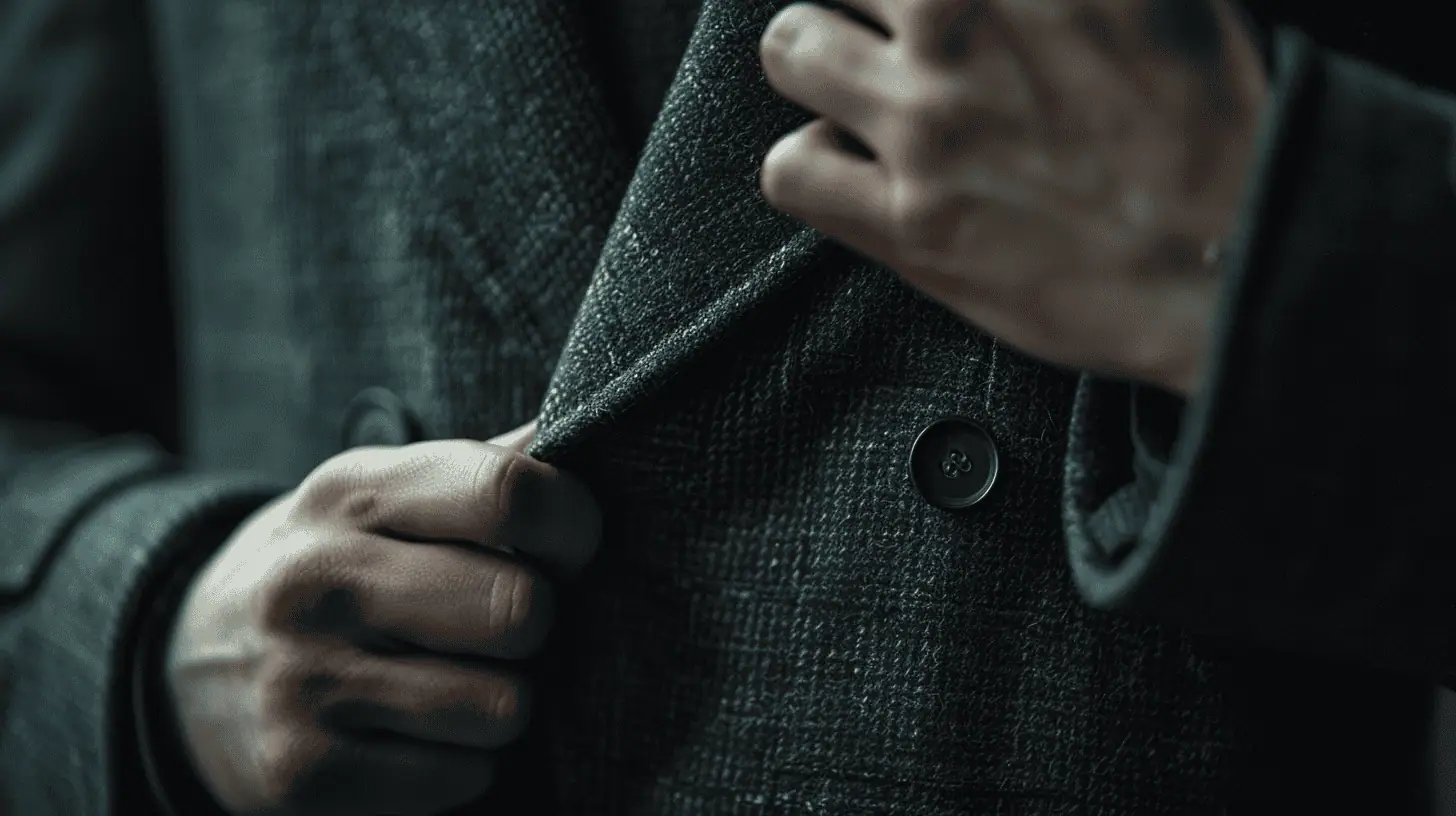
The strategic placement of buttons on a suit jacket directly influences its overall fit and appearance. When you’re getting fitted for a suit, you’ll notice that tailors pay careful attention to button alignment, as it affects how the fabric drapes across your body. The position of each button creates natural break points that enhance your silhouette and allow for proper fit adjustments.
Modern tailoring focuses on placing buttons at your body’s natural waistline, typically falling just above your navel. This placement creates a balanced look while allowing comfortable movement. You’ll find that proper button positioning helps prevent unsightly pulling or gaping when the jacket is closed, guaranteeing a polished appearance.
Here’s what you need to know about proper button placement:
When you’re having a suit tailored, the position of your buttons can be adjusted slightly to accommodate your body type. This customization guarantees that your jacket hangs properly and creates clean lines when buttoned.
Remember that proper button placement isn’t just about aesthetics – it’s essential for the jacket’s functionality and your comfort throughout the day.
Yes, your buttoning techniques can impact your suit jacket’s longevity.
When you consistently button and unbutton your jacket correctly, you’ll minimize stress on the fabric and buttonholes, enhancing fabric durability.
However, if you’re rough with the buttons or leave them fastened while sitting, you’ll create unnecessary tension that can stretch or damage the material over time.
To protect your investment, make sure you’re gentle with the buttons.
Yes, your body shape can influence button styles and standard rules.
If you’re tall and lean, you’ll likely follow traditional buttoning guidelines easily. However, if you have a larger midsection or unique proportions, you might need to adjust your fit preferences.
Don’t feel bound by conventional rules – your comfort and aesthetic choices matter most. The key is finding a buttoning style that flatters your specific build while maintaining a polished appearance.
Picture yourself as a conductor, orchestrating every element of your outfit into perfect harmony.
When it comes to suit aesthetics, you’ll want your metal accessories to sing the same note. You should coordinate your suit buttons with your belt buckle, watch, and cufflinks for a polished look.
However, don’t stress if they’re not an exact match – subtle variations in metal tones can actually add sophistication to your ensemble.
You’ll find button replacement costs vary considerably based on button materials and button styles you choose.
Basic plastic buttons might cost $2-5 each, while premium options like horn, mother-of-pearl, or metal can run $10-30 per button.
Most suit jackets need 3-6 buttons total.
Don’t forget labor costs – a professional tailor will typically charge $15-30 for the service.
For a complete set, you’re looking at $30-150 total.
Like adjusting the sails on a ship, your suit buttons can indeed adapt to your changing physique.
When you’ve experienced weight changes, you can have a tailor move your suit’s buttons sideways by up to an inch, ensuring a proper fit around your midsection.
While button styles shouldn’t change, you’ll find this alteration particularly helpful for single-breasted jackets.
So now you’re in the know about why you should button your suit jacket—a tradition that’s survived longer than your Netflix subscription. Whether you’re following King Edward VII’s fashion-forward choices or sticking to modern buttoning rules, you’ll look polished and professional. Remember, when it comes to suit buttons, less is more, and proper buttoning will always keep you looking sharp in any formal setting.



